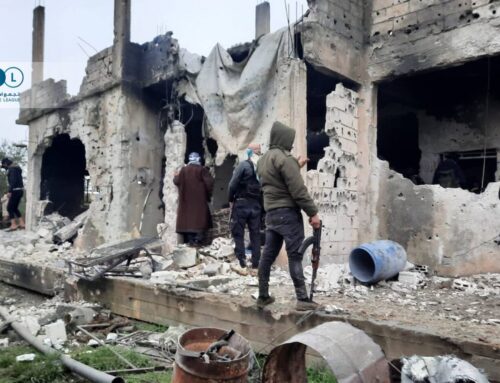‘Despite regime violations, the truce has lifted a huge burden’
January 14, 2015 Nearly a year ago, the pro-opposition towns […]
14 January 2015
January 14, 2015
Nearly a year ago, the pro-opposition towns of Yelda, Babila and Beit Sahem in southern Damascus agreed to truces with regime after being encircled by government forces for months. The three towns form a line next to the strategic road to the Damascus International Airport.
Despite the fact that residents of the three towns were once strongly anti-regime, years of war and poor living conditions have shifted their stances.
Most recently, the regime allowed two Red Crescent vehicles with food aid into Yelda on Monday, reported the regime-affiliated newspaper Al-Watan.
In related south Damascus news, Al-Watan also reported that Jabhat a-Nusra, which has maintained a presence in Beit Sahm despite the truce, withdrew from the town on Monday.
The regime has previously bombed Beit Sahm, citing the presence of “terrorists,” and causing strained relations between Nusra and the residents.
Even though the regime continues to regularly breach the terms of the agreements, the truces “have lifted a huge burden from the people’s shoulders,” Walid al-Agha, a 25-year old citizen journalist in Beit Sahm, tells Syria Direct’s Ammar Hamou
“People aren’t suffering from starvation anymore.”
Q: What did civilians hope to accomplish with the truces?
The reason behind the truces in the towns of Babila, Yelda and Beit Sahm was to end the regime blockade, especially after the deaths of 200 people as a result of poor nutrition, starvation, and lack of medicine during the blockade.
With regard to the neighborhoods of al-Qadam and al-Asali the situation is different: The displaced people wanted to return to their homes.

Q: Is it true that the regime violated the truce? If so, how did they do so?
The regime does not hold up their end of the truce in all of the areas. The violations range from incursions to sniper attacks to arbitrarily detaining civilians at checkpoints.
In addition, pro-regime Shiite groups [Iranian, Afghani and Iraqi militias, Hezbollah fighters] do not abide by the truce or even recognize it, which has led to several clashes.
Q: Why are other neighborhoods still trying to make truces with the regime, despite the fact that the regime has demonstrated that it doesn’t abide by the terms it sets?
Despite the regime’s numerous violations, the truce has lifted a huge burden from the people’s shoulders. People aren’t suffering from hunger anymore in southern Damascus after the truces.
Q: Do the opposition forces abide by the truces in south Damascus?
Yes, and all of the defiance [resisting] against the regime were reactions for breaching the ceasefire conditions.
Q: What does the regime gain from the truce in south Damascus?
It neutralizes and stabilizes a wide area that is adjacent to the heart of Damascus.
Moreover, the regime wants to present itself as trying to reach a political solution. This meets the international community’s wishes for it.
Q: What problems do the people in south Damascus face during the truce?
The people have suffered from a continuous lack of drinking water for over three months. There is also an economic blockade; it is true that we aren’t starving anymore, but people have no money to afford their living expenses since there are no jobs opportunities in these areas.
Q: Are there some terms of the truce that the regime agreed upon, but never implemented?
The roads [into the towns] were not opened entirely, and the regime did not release all of the detainees.
For more from Syria Direct, like us on Facebook or follow us on Twitter.







